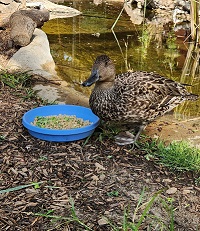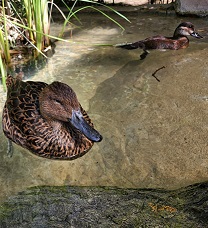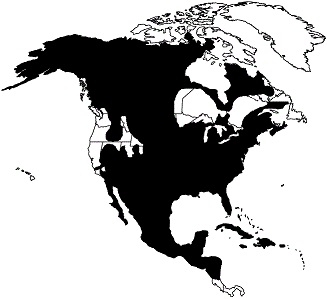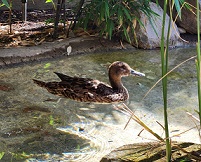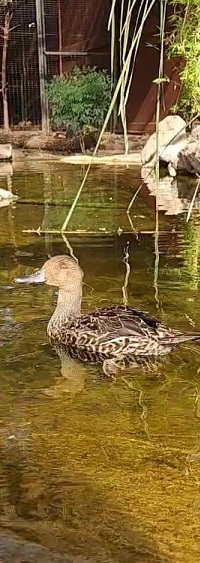Nothern
Pintail
Anas acuta
- Habitat: Wetlands including freshwater marshes
- Range: Widely distributed - North and Central America, Columbia in South America, Asia, Africa, and Europe including Iceland
- Natural Diet: Omnivorous - leaves, seeds, pondweeds, insects, crustaceans, and arachnids
- Status In The Wild: Common
All about the Northern Pintail Duck
The Northern Pintail ducks are elegant large-sized birds. With slender necks and long pin-pointed tails held high, giving them their name. The females have a dappled appearance with light brown faces, breasts and underbellies, and darker brown backs and wings. The males have chocolate-colored heads and black, grey, and cream primary feathers and are distinctive with a white stripe running across their chocolate-colored necks. Some males have splashes of iridescent blue and bronze on their primary feathers during the breeding season. The Northern pintails like other ducks have pointed beaks, flattened along the edges, and short legs that are positioned at the far end of their bodies which is an evolutionary adaptation for swimming. Their webbed feet are another unique adaption that helps them swim more smoothly. These ducks are around a foot in body length with a wide wingspan of up to three feet. They weigh around one to two pounds.
Diet/ Habitat/ Range
Northern Pintail ducks are found in North America (Canada, USA, and Mexico), the Caribbean Islands, Central America (Belize, Costa Rica, El Salvador, Guatemala, Honduras, Nicaragua, and Panama), South America (Columbia and Venezuela), Europe, northern Africa, and Asia (the Middle East, South Asia, and South-East Asia). Their breeding habitats include freshwater, brackish, and saline wetlands, estuaries, and bays.
These ducks mainly feed on aquatic invertebrates, larvae, and mollusks. They also feed on aquatic plants (seeds, roots, tubers, green parts).
Behavior
Northern Pintail Ducks are highly gregarious during the non-breeding season (winter) and it has been documented that they combine with other species of ducks to form mixed flocks that migrate southwards to their winter grounds in the fall season. In the breeding season, Northern Pintails migrate northwards in species-specific flocks to their breeding grounds.
They are ‘dabbling ducks’ feeding by tipping their bodies head-first into the water, instead of diving. They mostly feed on the surface of the water dipping as far as they can reach below the surface. They use their flat beaks to filter water and collect nutrients such as water weeds and microorganisms. On land, they use their beaks to funnel into the ground to capture worms, small mollusks (snails, slugs, mussels, and oysters), and small crustaceans (crabs, crayfishes, shrimps, prawns, krill, and barnacles).
Reproduction
Northern Pintail Ducks are seasonally monogamous with females usually partnering with only one male during the breeding season. They breed either as solitary pairs or in loose groups once a year with the breeding season lasting from late spring through the summer months. Several males have been observed to exhibit courtship displays to a single female following her until she has made her selection. Their vocalizations are most commonly heard during breeding season with males emitting a two-toned whistle to attract females. Females communicate by emitting vocalization that sounds like a “chatter”. The ducks usually form into pairs when they are at their wintering grounds during the first year of their lives. These pair bonds are maintained until the breeding season ends and the female has laid her eggs. They are likely to form pair bonds with other partners during the following year’s breeding season. The pair choose a place to build their nest, usually in vegetation along the banks of a waterbody where they are able to hide their nests, eggs, and ducklings from predators. The female Pintail Duck can lay up to 12 eggs in each clutch. While the female incubates the eggs and feeds the ducklings until they fledge when they are around 1.5 to 2 months old, the male protects the female and ducklings from predators and other males. The ducklings reach sexual maturity by one year of age.
Conservation/Status
Since the Northern Pintail Duck populations in the wild have been estimated to be stable currently, they are categorized as Least Concern by the International Union for World Conservation.
